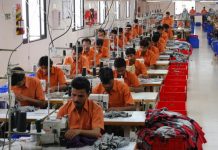London
Beth Ranson visits the highly anticipated New Designers event in London and talks with some stand out designers.
As the largest graduate exhibition in the UK, New Designers is an exciting opportunity to view upcoming creative talent from universities across the UK. Anticipation for this 2022 event was particularly strong as the physical show made its return after two years away due to the global pandemic.
During Week 1, 29th June – 2nd July, Fashion and Textiles students displayed their work along with Costume, Jewellery, Ceramics and Contemporary Design courses. Knitting Industry Creative visited the Business Design Centre in Islington, London to see the show and caught up with some of the graduate knitters whose work truly stood out.
Zsofia Juhasz
MA Fashion Knitwear Design, Nottingham Trent University
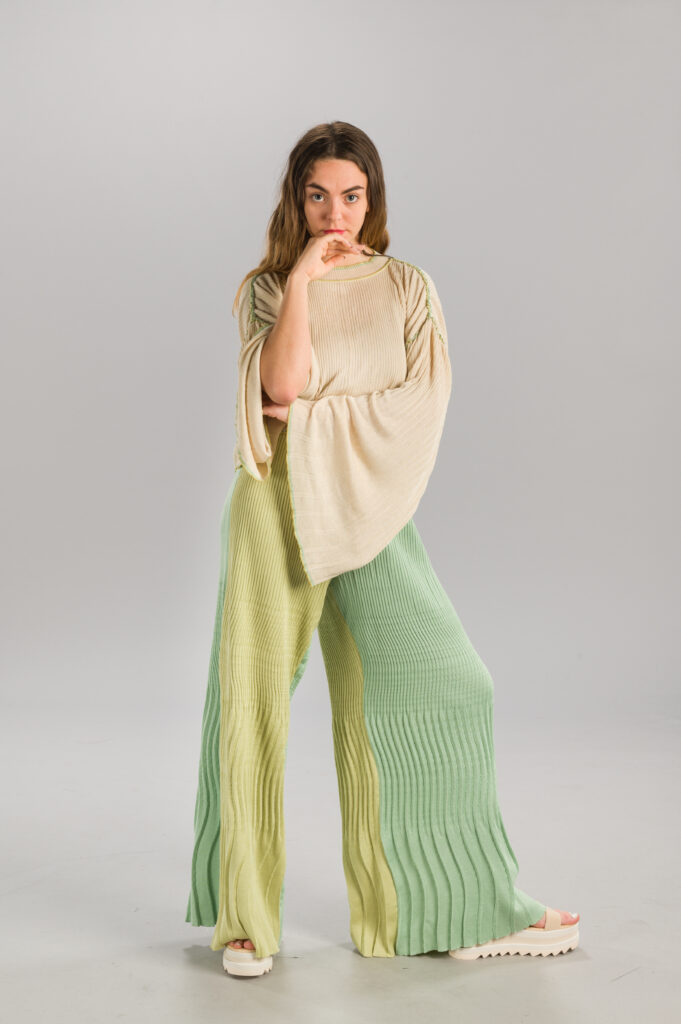
Zsofia Juhasz studied her BA in Fashion Design at Manchester School of Art before venturing on to her MA at Nottingham Trent. She specialises in stitch innovations in hand and power machine knitting, with Stoll and Shima Seiki programming became a strong focus during her MA. Sharing the initial inspiration behind her collection of garments and samples, Zsofia explained: “My project was inspired by growing crops in my garden – this is where my visual research came from for colours and textures. I was also inspired by nostalgia for my childhood. Growing up both of my grandads were avid gardeners, and now that I have my own garden this has become one of my favourite pastimes too. This resonates with the idea of mindfulness, appreciation and respect for nature that is important to me in my design philosophy.”
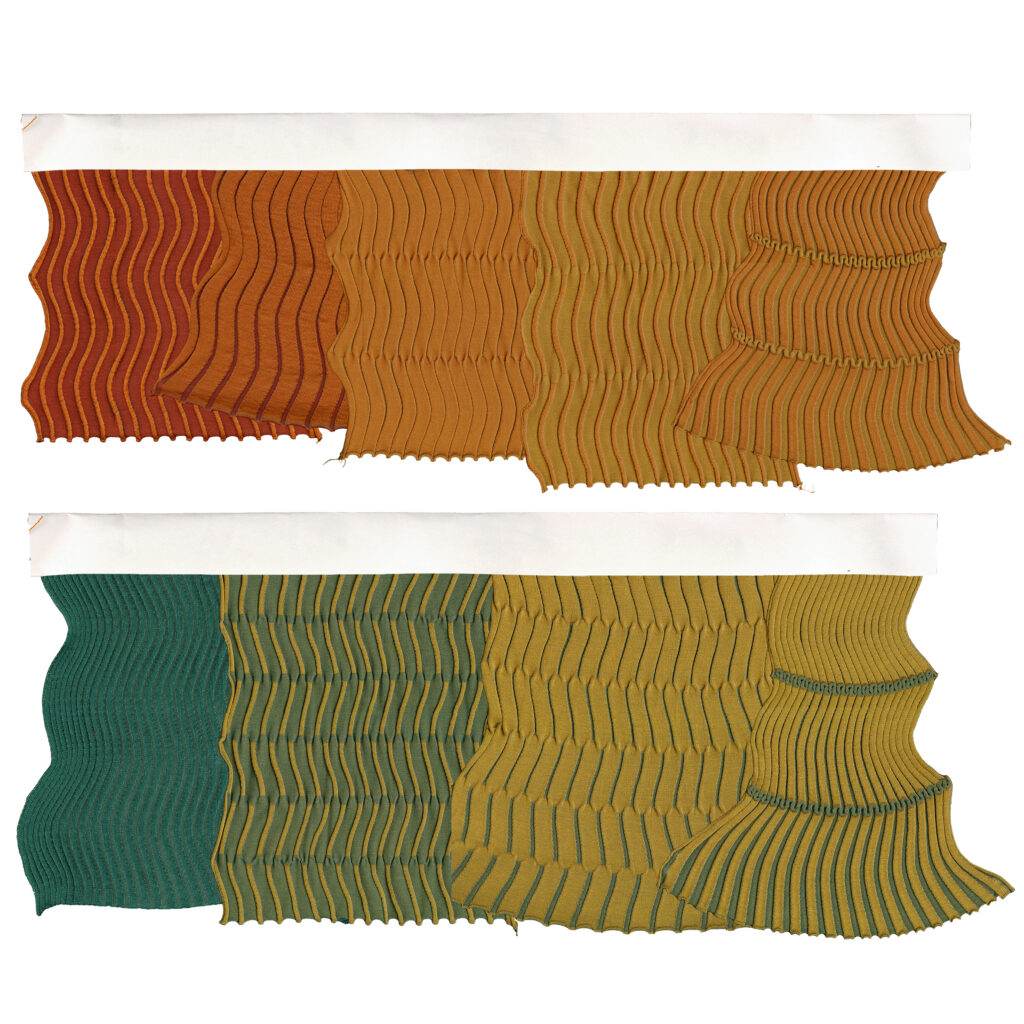
This research inspired organically flowing shapes and patterns with ‘wavy movement’ which Zsofia translated into knitted outcomes by experimenting with knitted structures and colour placement. Central to her philosophy was the importance of creating emotional engagement with her fabrics. “My fabrics are designed with the wearer in mind. Both emotional and physical longevity of my pieces were central to my work. I intended to create fabrics and garments that are comfortable, durable and beautiful, with high quality materials and finishes,” Zsofia said. Generous sponsorship from Zegna Baruffa for her MA collection enabled Zsofia to utilise cashwool alongside deadstock merino wool, cashmere and silk.
Zsofia’s fully fashioned collection was manufactured using Dubied hand flat machines as well as Shima Seiki and Stoll power knitting machines. Using deadstock yarns created some challenges though. “Sometimes working with deadstock yarns can be a challenge, as I had to adapt to what was available. I am very particular about colour, and often I could only find very limited quantities of some yarns. I managed to source undyed deadstock silk so I was able to dye a particular colour I wanted in the university dye lab. I spent days achieving the result I wanted instead of buying the yarn brand new,” she added.
The attention to detail within this collection is commendable and Zsofia has received much industry recognition. Her sponsorship from Zegna Baruffa was followed by winning 1st prize for the 2022 Shima Seiki Student Competition. The Worshipful Company of Framework Knitters also recognised the potential in her collection, awarding Zsofia a bursary towards her collection.
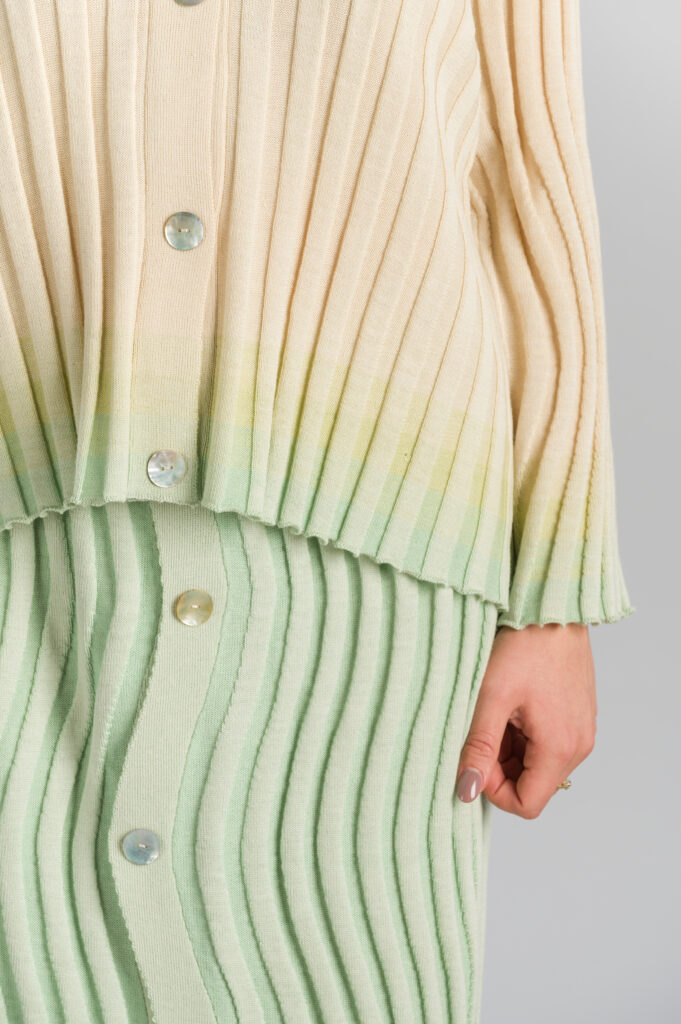
This level of industry recognition is a testament to Zsofia’s technical and creative abilities. Continuing to explore her creative practice in her home studio on her Dubied Machine, Zsofia is excited to see what the future holds.
Zsofia’s Instagram: @zsofia.knits
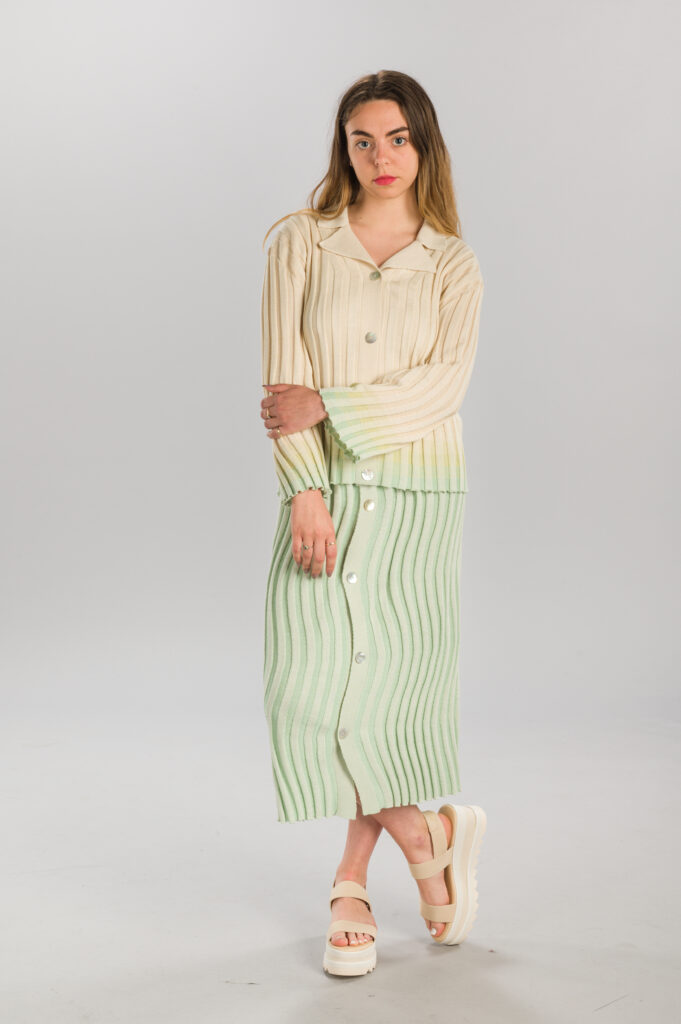
Rosie MacDougall
BA Textile Design, Glasgow School of Art
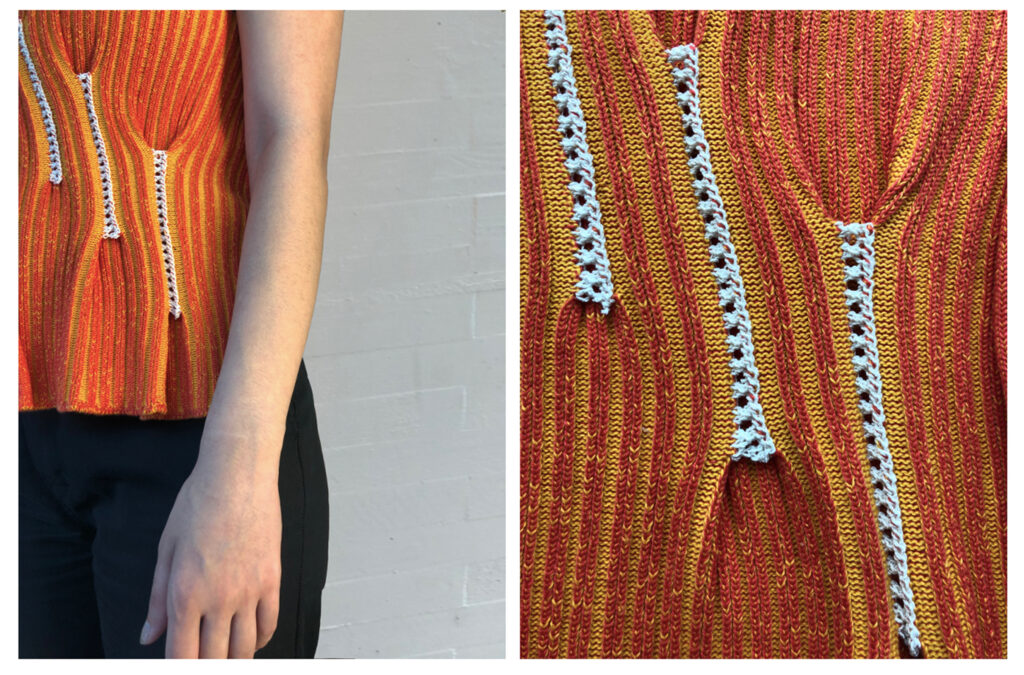
Rosie’s graduate collection was inspired initially by the textures and surface patterns of shells. Keen to gain as much technical understanding as she possibly could, Rosie taught herself how to fully fashion garments during the global pandemic and put these skills to great use within the collection. She has combined varied techniques and structures to gather her knitted fabrics in interesting ways. Rosie worked with garment details in mind from the very beginning. Collages and creative paperwork generated initial ideas which Rosie then draped on the stand to test scale, placement and composition ideas.

Aiming to use minimal quantities of petrochemical based yarns, Rosie focussed on the use of natural fibres such as cotton, cashmere and viscose. Where necessary she added elastic to achieve structural contrasts. Explaining how she produced her fabrics, Rosie said: “I used a mixture of Dubied and domestic knitting machines to create my fabrics. My final year was the only year I had access to Dubied machines because of the pandemic, so I tried to experiment and learn as much as possible about Dubied techniques in this short space of time. Many of my samples are reflective of this explorative learning process. Several of my samples were knitted on the Dubied and transferred to the domestic machine to create lace hole embellishments or link them together. I also experimented with post-machine processes by weaving yarns and knitted cords through my samples to embellish and connect pieces.”
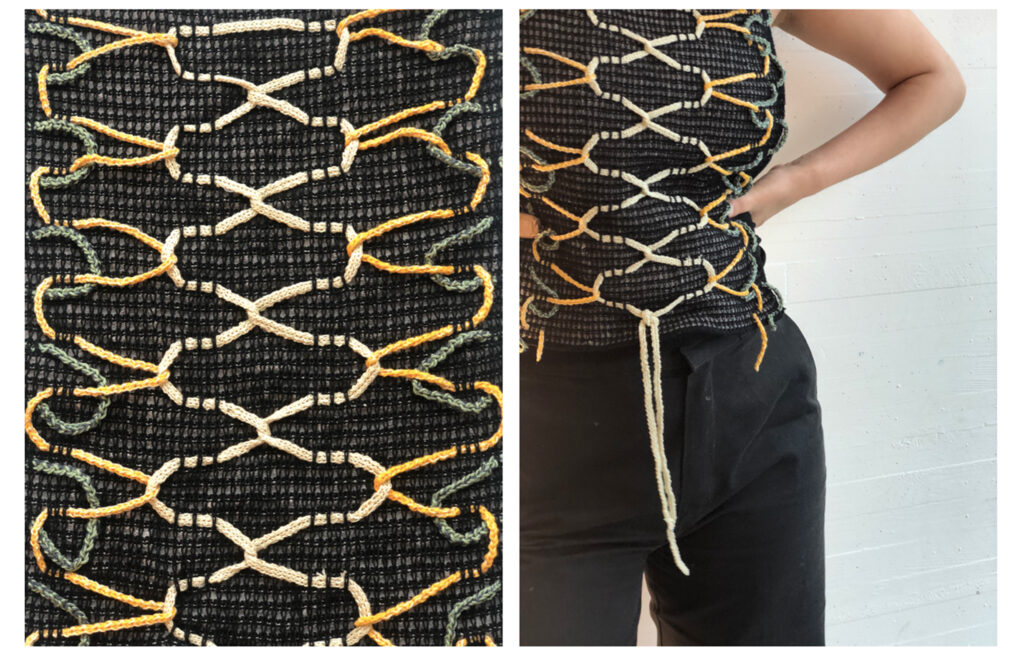
For her collection, Rosie was awarded a bursary from The Worshipful Company of Framework knitters. Already selling her knitwear through her own online concept store, Rosie plans to build her business further and expand on her current design offering in future.
Rosie’s Instagram: @rosie_macdougall
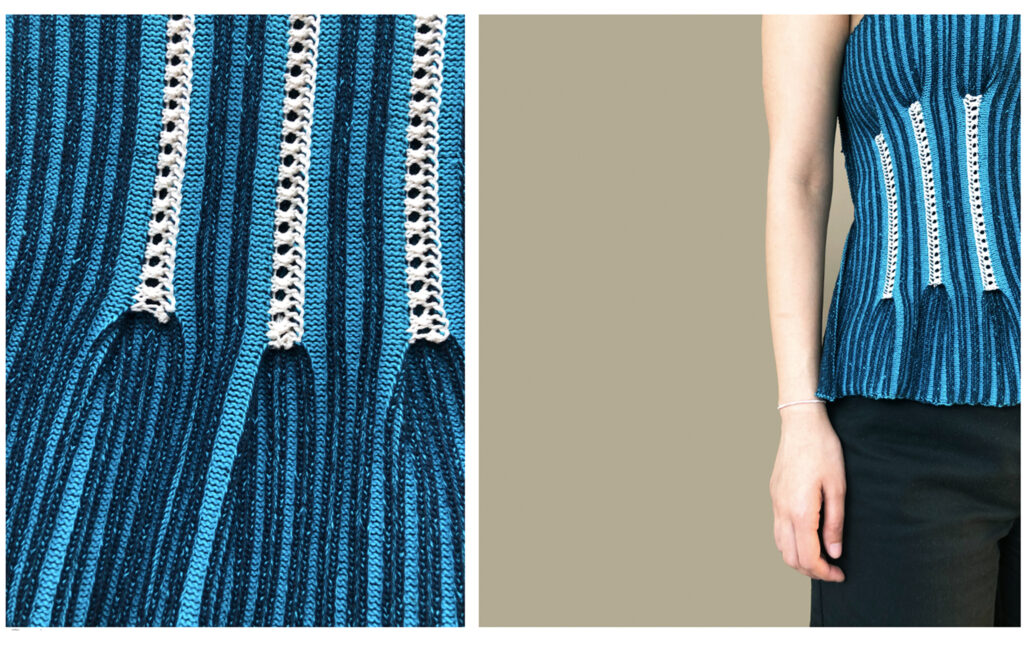
Rachel Leith: ‘The world today doesn’t make sense, so why should I make clothes that do?’
MA Fashion Knitwear Design, Nottingham Trent University

Rachel studied her BA at Middlesex University before joining Nottingham Trent to complete her MA. Explaining the two formative inspirations for her collection Rachel shared: “My project was based upon Picasso and the Cubism art movement. More specifically the themes of hidden identity presented within this art resonated with me. The artists try to capture a face from multiple angles resulting in paintings that appear fragmented. This alluded to the idea of distorted identities. The second theme was to design avaunt guard clothing that adjusted to fit a wide range of genders.”
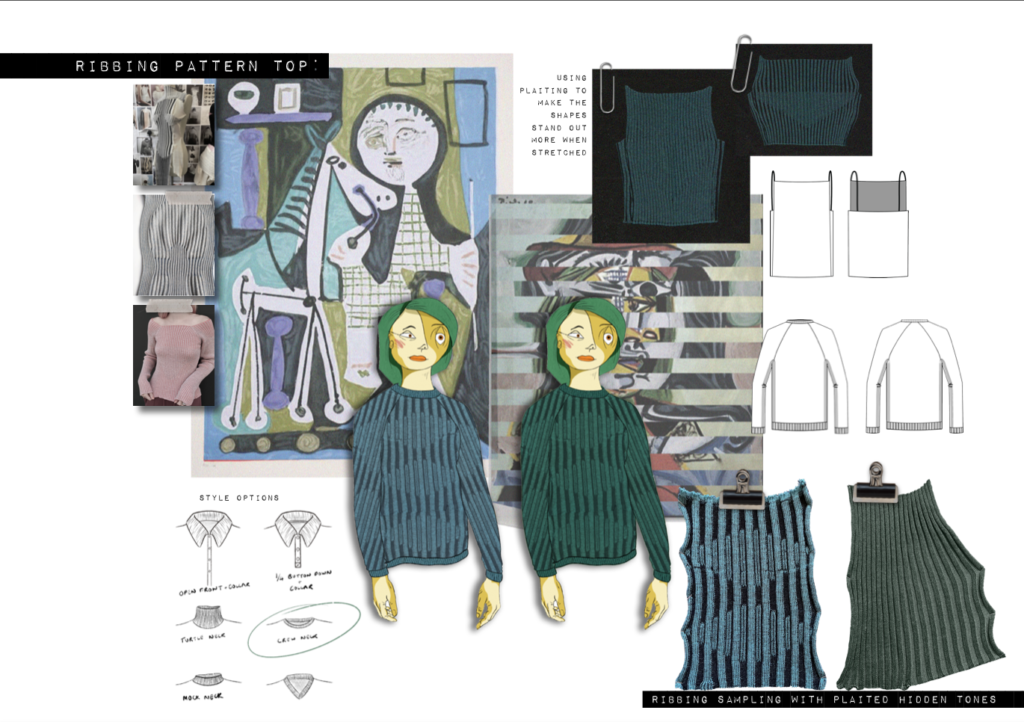
Rachel’s garments showcase a variety of knitted stitches, from cables and ribs to birds-eye jacquards and filled pockets. She utilised dead stock yarns within her material palette including mohair to create surface texture, merino wool, cotton and viscose. Soft, wearable hand feel was important for Rachel, as well as creating textural contrasts using viscose on the 14gg Dubied contrasted with mohair in other fabrics. Sampling initially on the Dubied machines, Rachel then translated her hand flat samples into digital programmes to knit on the Shima Seiki and Stoll machines.
In making her garments, Rachel faced the challenge of constructing patterns that were gender neutral, able to adapt and fit to a variety of body shapes and sizes. Rachel explained: “When designing clothing for multiple genders its always difficult to work out the fit of the garments so the main challenge was coming up with ways to have my clothes adjust to different shapes. I did this through adjustable channels and toggles, ribbing panels and wrap around ties to allow the wearer to fit the garment to themselves.”
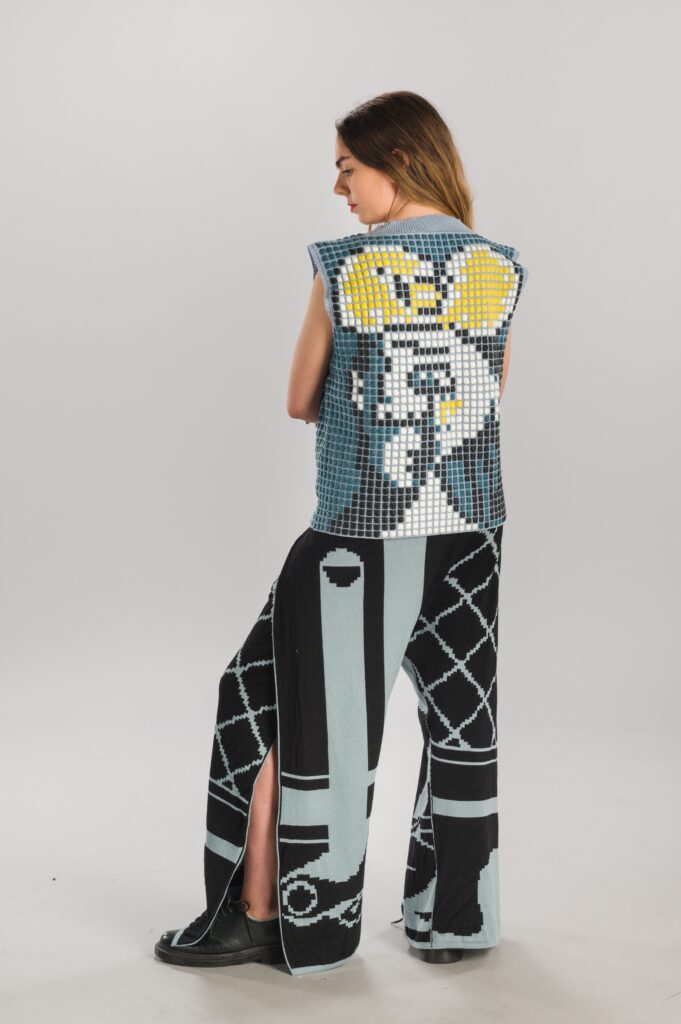
Rachel’s love for the technical side of knitting pushes her to problem solve in fabric focussed ways. Her abilities across hand flat knitting and power machine knitting and programming are showcased impressively within her graduate collection. Building on this skillset even further in the coming months is Rachel’s aim, hoping to join the industry as a knit programmer or garment technologist in the future.
Rachel’s Instagram: @Leithal_Knitting
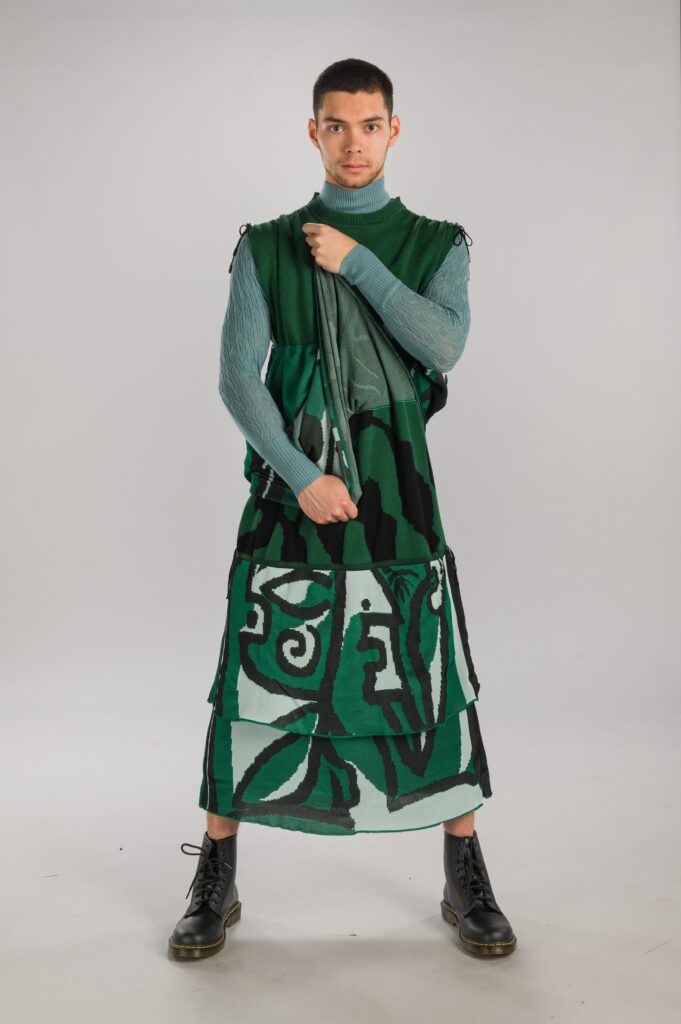
Emily Dickson: ‘Reading Fractals’
BA Textile Design, Glasgow School of Art
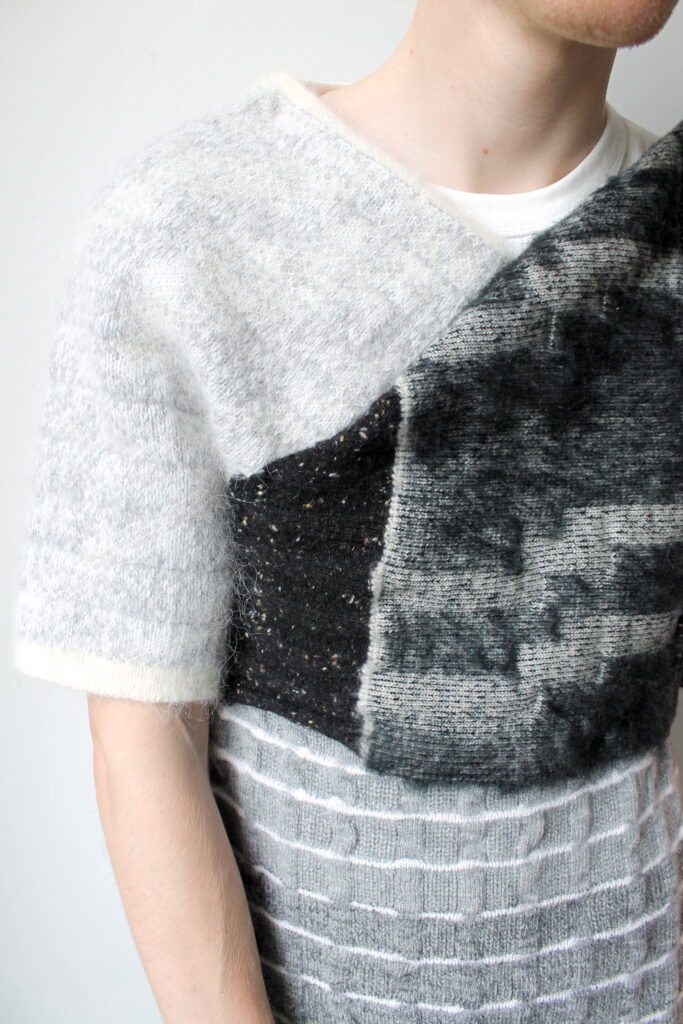
Inspired by the highlights, colours, tones and textures of landscapes and naturally occurring patterns, Emily’s collection of fabrics echoes her love for the outdoors. She shared: “My work as a designer, particularly when drawing, often shifts between working analogue and digitally. I’ve always been drawn to rigid, uniformed shapes like paving slabs or windows on tower blocks. But there’s also part of me which loves the slightly coordinated chaos you can see in the landscape of sweeping lines. Knitting allows me to translate and listen to both these sides of my brain when designing. I’m usually most excited about yarn/ fibre choice, after drawing, and how this can add to the story of a design through material qualities.”

In addition to the visual influences of her primary research, Emily was also influenced by the layering system of outdoor clothing. “I was interested, conceptually in how we move through a landscape as people, whether it be scrambling up rocks, walking over the peaks of hills or wading through valley rivers. The natural environment and hiking can be a space of comfort and serenity, but it can also be dangerous. It is instilled in us the importance of safety when walking through the layering of your clothing; a fine gauge breathable base layer, a cosy insulative and protective shell,” she said.
Approaching her garment and fabric creations with this in mind, Emily sought to design 14gg ‘base layers’ using cashmere, merino wool, silk and stretch viscose. She also created 14gg intarsias as well as lightly felted British Wool in net jacquards created dense fabrics to layer with her lighter weight pieces.
A bursary award from the Worshipful Company of Framework Knitters helped to fund Emily’s yarns for the collection. The inclusion of British Wool in her collection was important to Emily. “I have used Blue-faced Leister, Marsham and Teeswater British wool. I am interested in finding ways British wool can be used more since only a small percentage of UK fleeces are sold for fashion purposes and there are over 70 different breeds, each with different yarn characteristics,” she explained. This is an area that Emily hopes to continue exploring within a fashion context.

Continuing to knit, build her knowledge and explore her creativity even further, Emily hopes to gain opportunities in knitwear production and programming roles, ideally focussing on sustainable fashion.
Emily’s Instagram: @emilyddesigns
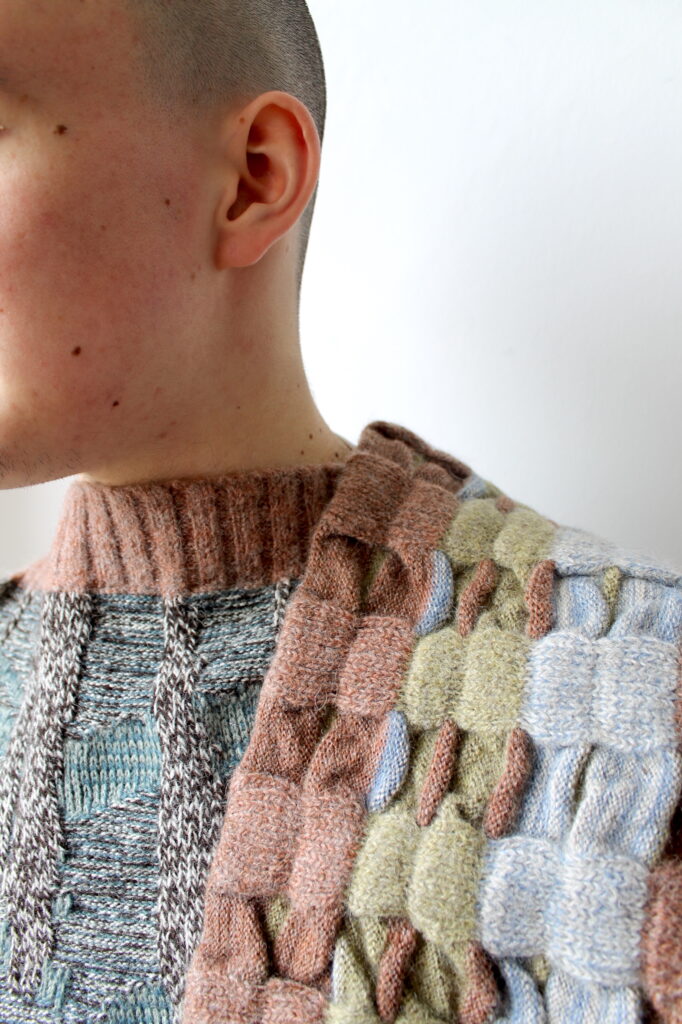
Danna Lin: ‘Traces of Verdant’
BA Fashion Textiles, Knit, UAL London College of Fashion
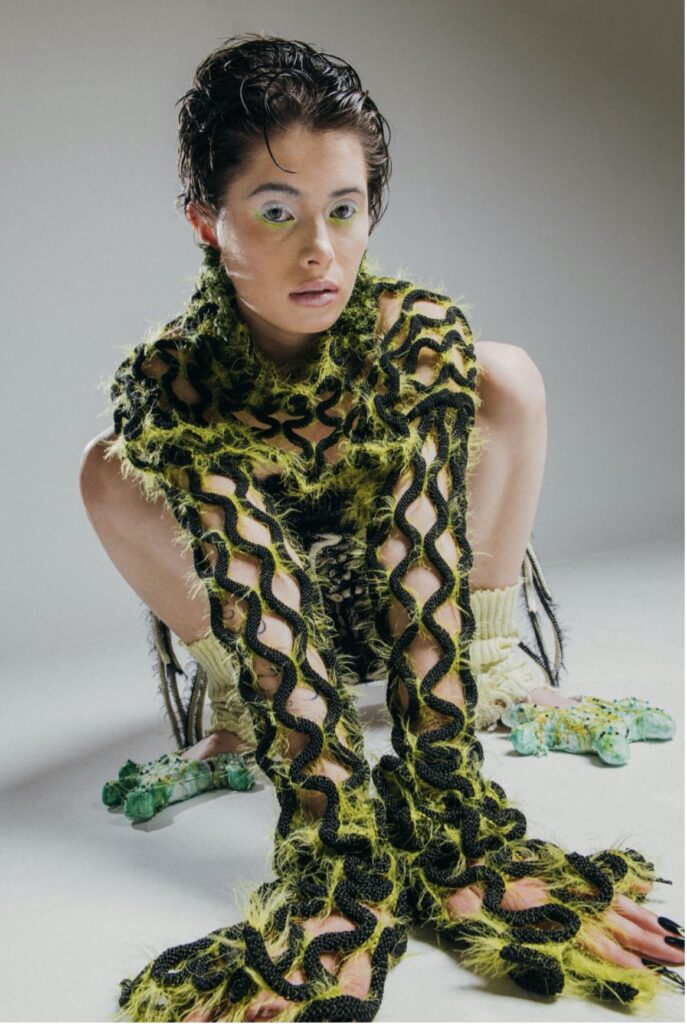
Playfulness combined with technical ability is at the heart of Danna’s graduate collection. Danna focusses on how knitted fabrics can initiate garment ideas, experimenting with a variety of colour combinations and 3D structures to create her designs.
Sharing the inspiration behind her project, Danna explained: “Traces of Verdant, is an experimental craft collection inspired by the relationship between nature and human architecture. I wanted people to understand the impact of humans on nature through the contrast between soft and hard fabrics. The feeling of constraint and roughness that people feel when wearing these clothes intentionally expresses the touch of plants on architecture. In terms of colour, I used a lot of black, white and grey to express the distance and industrial feel of the architecture. Green and yellow green is used to represent the vitality of plants. I hope that through touch and colour people will become aware of the impact of architecture on nature and thus respect and care for it more.”
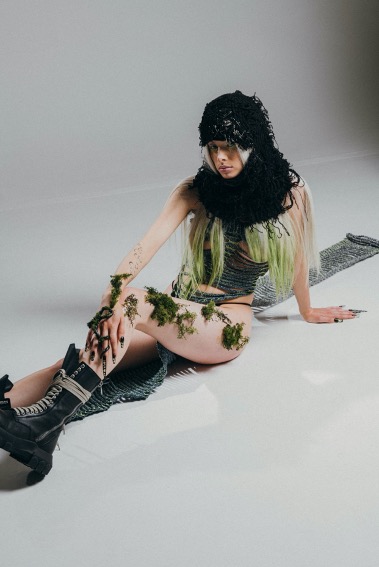
Heavily used techniques within Danna’s collection include ripple stitch and casting on/off techniques. This gives the fabrics a distinctive linear aesthetic, echoing the straight lines of architecture in her primary research. She explored Stoll power machine knitting as well as hand crochet and Dubied machine knitting.
Material choices and processes were heavily influenced by Danna’s research into architecture too. “In terms of materials, I took a new approach by incorporating knitted fabrics into the buildings. I used plaster and cement to soak knit samples. I also used some hard materials such as glass wax and mirrors in combination with the fabrics to convey a sense of conflict between the plants and the architecture. In the design process I used different materials to differentiate the relationship between plants and architecture (e.g. using wax rope and feathers). I also combined different tensions and techniques to create looseness contrasted with constriction,” she said.
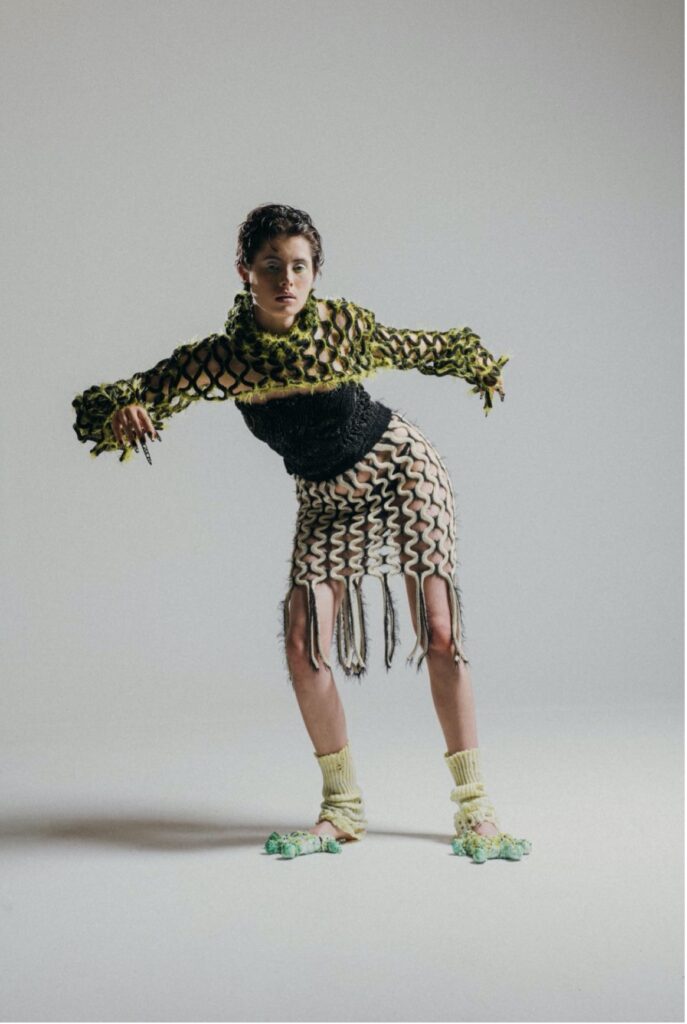
Calculating pattern pieces for ripple stitch fabrics is always challenging, but Danna developed her skills of tension square development and pattern creation and successfully made her first ready-to-wear collection.
Danna plans to study an MA to further her knitwear and knitted textiles skills within her creative practice, hoping to one day launch her own knitwear brand, working collaboratively wherever possible.
Danna’s Instagram: @lindannadolly


Subscribe To Our Newsletter
Join our mailing list to receive the latest news and updates from our team.













